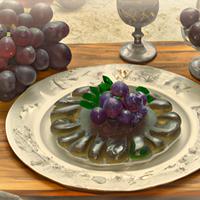
1 serving (20 grams) contains 50 calories, 0.0 grams of protein, 0.0 grams of fat, and 13.0 grams of carbohydrates.

Log this food in SnapCalorie

Nutrition Information
Calories |
595.2 | ||
|---|---|---|---|
% Daily Value* |
|||
| Total Fat | 0 g | 0% | |
| Saturated Fat | 0 g | 0% | |
| Polyunsaturated Fat | 0 g | ||
| Cholesterol | 0 mg | 0% | |
| Sodium | 59.5 mg | 2% | |
| Total Carbohydrates | 154.8 g | 56% | |
| Dietary Fiber | 0 g | 0% | |
| Sugars | 119.0 g | ||
| protein | 0 g | 0% | |
| Vitamin D | 0 mcg | 0% | |
| Calcium | 0 mg | 0% | |
| Iron | 0 mg | 0% | |
| Potassium | 119.0 mg | 2% | |
* Percent Daily Values are based on a 2,000 calorie diet. Your daily values may be higher or lower depending on your calorie needs.
Food Attributes
Source of Calories
About Jelly grape
Jelly Grape is a sweet and vibrant fruit spread made primarily from grape juice, sugar, and pectin, which gives it a smooth, jelly-like texture. Commonly found in Western cuisines, it is a staple in breakfasts, snacks, and desserts, often paired with bread, crackers, or peanut butter. Originating from traditional methods of preserving fruits, Jelly Grape has become a popular household item due to its convenience and flavor. While Jelly Grape is a source of quick energy because of its sugar content, it lacks fiber, vitamins, and minerals typically found in whole grapes. It contains added sugars that may not be ideal for diets focused on reducing caloric intake or managing blood sugar levels. For a healthier alternative, opt for varieties that are made with reduced sugar or natural sweeteners. Always check labels, as ingredients and nutritional values vary between brands.



